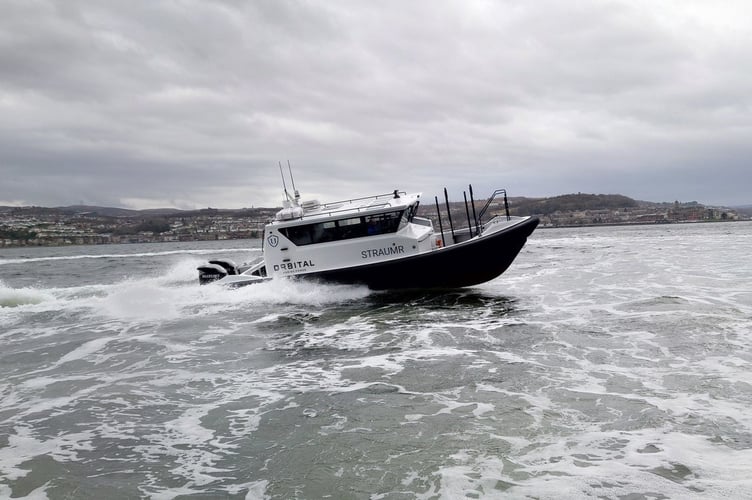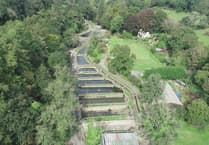There is a growing awareness of the global problem of fibreglass disposal.
It is a material widely used in many areas, including boat building, reinforced plastics, construction and electronics, but it cannot be fully recycled when it comes to the end of its useful life. It’s basically another plastics mountain, waiting to happen.
Ironically, one of the biggest uses of fibreglass is to make the carbon fibre blades of ‘eco friendly’ wind turbines.
It is estimated that the global wind industry will need to decommission 85GW of capacity – including 325,000 blades – by mid-century.
This will mean that an estimated 43 million tonnes of redundant blade material will end up in landfill between today and 2050 worldwide.
It is an issue which is being addressed by ExoTechnologies, a maritime green technologies start-up, based in the Isle of Man.
Ultimate Boats, which is owned by ExoTechnologies, has just delivered a fully recyclable, high-performance workboat to tidal turbine developers Orbital Marine Power.
The new vessel will be working as a support boat for Orbital’s innovative project which will provide 30MW of tidal energy from off Orkney.
Shane Mugan, ExoTechnologies’ chief executive officer, who lives in the island, says: ‘We are very proud to be working with Orbital Marine Power to support its pioneering work in the field of green energy.’
The new vessel is made from DANU TM , a potentially game-changing material, which was actually invented in the island, by Dutchman, Jeroen Wats, who lives in Castletown.
He is a former yacht designer and passionate yachtsman.
In 2003 he took part in the transatlantic race from Cape Town to Rio de Janeiro as part of an eight-man crew on a boat named Mandiba, after Nelson Mandela.
They won the race, covering the 4,000 nautical miles in 20 days, and raised a considerable sum of money for the Nelson Mandela Foundation.
However, Jeroen gave up the sport when he realised the environmental damage that carbon fibre – which racing yachts are built from – was causing. He set about developing an alternative.
He says: ‘To make something recyclable is fairly simple to make something superior to fibreglass – that’s also fairly simple. But to make something which is recyclable and superior and circular that’s the difficult part.’
When you ask how he did it, he smiles and says: ‘I took a “blender”, as you might say, and I put curiosity, experience, passion, everything in that blender.’
What he was aiming for was also a material which is what he calls ‘circular’.
This means that it can be used again without losing any of its mechanical properties. In other words, it is ‘circular’ because it keeps on going round again.
Jeroen says: ‘What we have with DANUTM is you keep the materials out of landfill and in the economy. You can take the fibres and the resins apart and you won’t use mechanical properties.
‘You can reuse them again and again and again and that is the unique part of it.’
Jeroen has exchanged his invention for shares in ExoTechnologies, after he met Shane Mugan, who was looking for a replacement for carbon fibre.
‘I have something that ticks all your boxes,’ he told him.
All of the boats made by Ultimate Boats are now made from DANUTM , including a patrol boat they recently delivered to Police Scotland. Jeroen is currently working with a number of companies on a range of projects including in the sports, leisure and green energy industries where the material can also be used.
Shane says: ‘Our fully recyclable DANUTM composite material technology can tackle the ecological timebomb which sees 250 million kilos of fibreglass and thousands of boats dumped into landfill across Europe each year.
‘Innovation and making a positive difference through the development of a renewable marine industry is at the heart of the work of both our operations.
‘That shows the potential of our market leading technologies, which we believe are capable of accelerating the green transition to a circular economy across all industries and markets. We know we are making a significant breakthrough in transforming boat building, as DANUTM can replace fibreglass. This latest deal with Orbital Marine Power underlines that.’
The workboat has been built at Ultimate Boats, the Glasgow boatyard owned by ExoTechnologies and is part of the full high-performance workboat range that it launched earlier this year.
The company says it plans to create 300 jobs at the yard within five years.
The 11 metre O-class Rigid Hull Inflatable Boat (RIB) can carry eight people and is adapted for the specific operational needs of Orbital Marine Power and the challenging sea conditions around Orkney.
It has a wheelhouse, shock mitigation units, access from the front and has an operating range of 450 nautical miles.
The vessel also features the company’s advanced ExoHullTM technology, designed and developed by Ultimate Boats internationally renowned chief designer John Moxham.
He has reimagined planning hull technology and hydrodynamic performance using principles that were first conceived during the development of the XB-70 Valkyrie supersonic bomber.
The hull design allows the boat to move quicker and more efficiently in the water, creating a more stable movement with less slamming impact and fuel saving.
Shane said: ‘We are seeing strong interest in our range of innovative and high-performance vessels from commercial and leisure operators.
‘The boat we are delivering for Orbital Marine Power will be a real workhorse, designed and built to operate in challenging waters.’
Would tidal power work on
the Isle of Man as a way of
producing green energy?
Jeroen, who has seen tidal power working in Holland for a number of years, is convinced that it would.
The Isle of Man has a suitable tidal range and the tides, unlike wind which has wide variations, are very reliable.
Jeroen says: ‘The tides are completely predictable: you know when they will come in and go out for the next 300 years.’
Orbital Marine Power has been developing tidal technology since 2002.
Each of its 2MW Orbital turbines has the ability to generate enough clean, predictable electricity to meet the demand of around 2,000 homes and offset approximately 2,200 tonnes of CO2 production per year.
Their project off Orkney is for 30MW, which would equate to approximately 12 Orbital devices installed across the site.
The waters around Orkney have significant tidal stream energy potential and the site offers just one example of how this can be harnessed to provide clean, predictable power.
Appendix 17 of the government’s net zero impact report deals with tidal power.
It says: ‘It is recommended that the Isle of Man maintain a watching brief on tidal technology as LCOE (levelised cost of energy) decreases and be ready to open expressions of interest from developers at the earliest opportunity.’


.png?width=209&height=140&crop=209:145,smart&quality=75)


Comments
This article has no comments yet. Be the first to leave a comment.